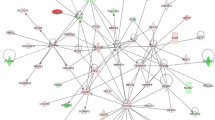Abstract
Peripheral nerve injury and regeneration is a complex biological process jointly mediated by numerous factors. Cyclic adenosine monophosphate (cAMP) modifies the cellular behaviors of neurons and Schwann cells, and thus may contribute to peripheral nerve regeneration. Despite the importance of cAMP, the temporal and spatial expressions of genes involved in cAMP-related signaling pathways during peripheral nerve regeneration remain unclear. In the current study, by using rat sciatic nerve crush model, we analyzed previously obtained RNA deep sequencing data, explored the significance of cAMP-mediated signaling pathway and protein kinase A (PKA) signaling pathway after peripheral nerve injury, and examined the expression patterns of genes involved in these cAMP-related signaling pathways. Our results, from the genetic aspect, emphasized the critical involvement of cAMP-related signaling pathways, identified the dynamic changes of some key signaling cascades, and may help the discovery of potential therapeutic targets for peripheral nerve repair and regeneration.






Similar content being viewed by others
References
Menorca RM, Fussell TS, Elfar JC (2013) Nerve physiology: mechanisms of injury and recovery. Hand Clin 29:317–330
Campbell WW (2008) Evaluation and management of peripheral nerve injury. Clin Neurophysiol 119:1951–1965
Sunderland S (1951) A classification of peripheral nerve injuries producing loss of function. Brain 74:491–516
Gu X, Ding F, Yang Y, Liu J (2011) Construction of tissue engineered nerve grafts and their application in peripheral nerve regeneration. Prog Neurobiol 93:204–230
Shin JE, Cho Y (2017) Epigenetic regulation of axon regeneration after neural injury. Mol Cells 40:10–16
Knott EP, Assi M, Pearse DD (2014) Cyclic AMP signaling: a molecular determinant of peripheral nerve regeneration. BioMed Res Int 2014:651625
Chen ZL, Yu WM, Strickland S (2007) Peripheral regeneration. Annu Rev Neurosci 30:209–233
Makwana M, Raivich G (2005) Molecular mechanisms in successful peripheral regeneration. FEBS J 272:2628–2638
Stewart HJ, Eccleston PA, Jessen KR, Mirsky R (1991) Interaction between cAMP elevation, identified growth factors, and serum components in regulating Schwann cell growth. J Neurosci Res 30:346–352
Jessen KR, Mirsky R, Morgan L (1991) Role of cyclic AMP and proliferation controls in Schwann cell differentiation. Ann NY Acad Sci 633:78–89
Aglah C, Gordon T, Posse de Chaves EI (2008) cAMP promotes neurite outgrowth and extension through protein kinase A but independently of Erk activation in cultured rat motoneurons. Neuropharmacology 55:8–17
Bacallao K, Monje PV (2015) Requirement of cAMP signaling for Schwann cell differentiation restricts the onset of myelination. PLoS ONE 10:e0116948
Yu B, Zhou S, Yi S, Gu X (2015) The regulatory roles of non-coding RNAs in nerve injury and regeneration. Prog Neurobiol 134:122–139
Yi S, Zhang H, Gong L, Wu J, Zha G, Zhou S, Gu X, Yu B (2015) Deep sequencing and bioinformatic analysis of lesioned sciatic nerves after crush injury. PLoS ONE 10:e0143491
Mortazavi A, Williams BA, McCue K, Schaeffer L, Wold B (2008) Mapping and quantifying mammalian transcriptomes by RNA-SEq. Nat Methods 5:621–628
Oliveros JC (2007) VENNY. An interactive tool for comparing lists with Venn diagrams
Chan KM, Gordon T, Zochodne DW, Power HA (2014) Improving peripheral nerve regeneration: from molecular mechanisms to potential therapeutic targets. Exp Neurol 261:826–835
Laurenza A, Sutkowski EM, Seamon KB (1989) Forskolin: a specific stimulator of adenylyl cyclase or a diterpene with multiple sites of action? Trends Pharmacol Sci 10:442–447
Kilmer SL, Carlsen RC (1984) Forskolin activation of adenylate cyclase in vivo stimulates nerve regeneration. Nature 307:455–457
Kilmer SL, Carlsen RC (1987) Chronic infusion of agents that increase cyclic AMP concentration enhances the regeneration of mammalian peripheral nerves in vivo. Exp Neurol 95:357–367
Klein HW, Kilmer S, Carlsen RC (1989) Enhancement of peripheral nerve regeneration by pharmacological activation of the cyclic AMP second messenger system. Microsurgery 10:122–125
Udina E, Ladak A, Furey M, Brushart T, Tyreman N, Gordon T (2010) Rolipram-induced elevation of cAMP or chondroitinase ABC breakdown of inhibitory proteoglycans in the extracellular matrix promotes peripheral nerve regeneration. Exp Neurol 223:143–152
Han PJ, Shukla S, Subramanian PS, Hoffman PN (2004) Cyclic AMP elevates tubulin expression without increasing intrinsic axon growth capacity. Exp Neurol 189:293–302
McQuarrie IG, Grafstein B, Gershon MD (1977) Axonal regeneration in the rat sciatic nerve: effect of a conditioning lesion and of dbcAMP. Brain Res 132:443–453
Walikonis RS, Poduslo JF (1998) Activity of cyclic AMP phosphodiesterases and adenylyl cyclase in peripheral nerve after crush and permanent transection injuries. J Biol Chem 273:9070–9077
Monje PV (2015) To myelinate or not to myelinate: fine tuning cAMP signaling in Schwann cells to balance cell proliferation and differentiation. Neural Regen Res 10:1936–1937
Bacallao K, Monje PV (2013) Opposing roles of PKA and EPAC in the cAMP-dependent regulation of Schwann cell proliferation and differentiation [corrected]. PLoS ONE 8:e82354
Acknowledgements
The authors are grateful to Professor Jie Liu at Nantong University for his help in the preparation of the manuscript. This work was supported by the Natural Science Foundation of Jiangsu Province, China (BK20150409); and Priority Academic Program Development of Jiangsu Higher Education Institutions (PAPD).
Author information
Authors and Affiliations
Contributions
SY conceived and designed the experiments. JY, SW, CW, and SY performed the experiments. JY and SY analyzed the data. SY Contributed reagents/materials/analysis tools. SY wrote the manuscript.
Corresponding author
Ethics declarations
Conflict of interest
The authors declare that they have no conflict of interest.
Electronic supplementary material
Below is the link to the electronic supplementary material.
11064_2017_2409_MOESM1_ESM.xlsx
Table S1. Differentially expressed genes in cAMP-mediated signaling pathway. The expression levels of genes in cAMP-mediated signaling pathway at 1, 4, 7, and 14 days after sciatic nerve crush were compared with 0 day and presented as log2Ratio (XLSX 35 KB)
11064_2017_2409_MOESM2_ESM.xlsx
Table S2. Differentially expressed genes in PKA signaling pathway. The expression levels of genes in PKA signaling pathway at 1, 4, 7, and 14 days after sciatic nerve crush were compared with 0 day and presented as log2Ratio (XLSX 48 KB)
Rights and permissions
About this article
Cite this article
Yu, J., Wang, S., Wu, C. et al. Deep Sequencing Reveals the Significant Involvement of cAMP-Related Signaling Pathways Following Sciatic Nerve Crush. Neurochem Res 42, 3603–3611 (2017). https://doi.org/10.1007/s11064-017-2409-3
Received:
Revised:
Accepted:
Published:
Issue Date:
DOI: https://doi.org/10.1007/s11064-017-2409-3




